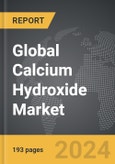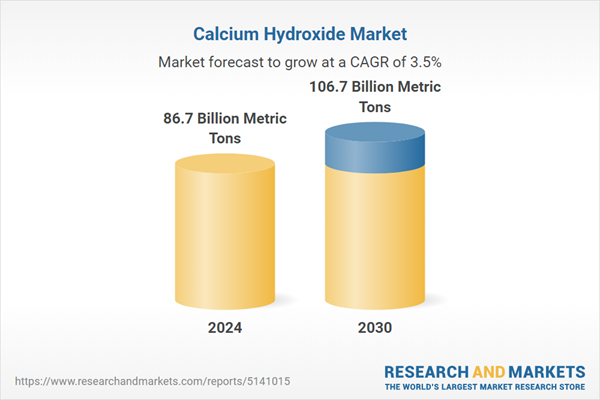The global market for Calcium Hydroxide was sized at 86.7 Billion Metric Tons in 2024 and is projected to reach 106.7 Billion Metric Tons by 2030, growing at a CAGR of 3.5% from 2024 to 2030. This comprehensive report provides an in-depth analysis of market trends, drivers, and forecasts, helping you make informed business decisions. The report includes the most recent global tariff developments and how they impact the Calcium Hydroxide market.
Segments: End-Use (Environmental Water Treatment, Chemical, Agriculture, Zinc, Other Applications).
Geographic Regions/Countries: World; United States; Canada; Japan; China; Europe (France; Germany; Italy; United Kingdom; Spain; Russia; and Rest of Europe); Asia-Pacific (Australia; India; South Korea; and Rest of Asia-Pacific); Latin America (Argentina; Brazil; Mexico; and Rest of Latin America); Middle East (Iran; Israel; Saudi Arabia; United Arab Emirates; and Rest of Middle East); and Africa.
The analysts continuously track trade developments worldwide, drawing insights from leading global economists and over 200 industry and policy institutions, including think tanks, trade organizations, and national economic advisory bodies. This intelligence is integrated into forecasting models to provide timely, data-driven analysis of emerging risks and opportunities.
Global Calcium Hydroxide Market - Key Trends and Drivers Summarized
How Does Calcium Hydroxide Support Critical Industrial Functions?
Calcium hydroxide, commonly known as slaked lime or hydrated lime, is a versatile inorganic compound with the chemical formula Ca(OH)2. It is produced by adding water to calcium oxide (quicklime) in a process known as slaking, which results in a fine, white powder or slurry. This compound has a long history of use across a wide array of industries due to its reactive nature and high alkalinity. One of its most prominent applications is in water treatment, where it acts as a pH adjuster, helping to remove impurities such as heavy metals and neutralize acidic waters. It is also used extensively in the construction industry, particularly in the production of mortar, plaster, and concrete, where it plays a key role in hardening and stabilizing these materials. Additionally, calcium hydroxide is essential in the production of paper and pulp, sugar refining, and as a neutralizing agent in chemical processes. Its adaptability to multiple industrial functions makes calcium hydroxide an indispensable compound for both large-scale industrial operations and smaller applications.How Is Calcium Hydroxide Used to Address Environmental Challenges?
Calcium hydroxide's role in environmental management is particularly noteworthy due to its ability to mitigate pollution and improve environmental sustainability. In water treatment, it is widely used to remove harmful contaminants from wastewater, making it a key component in municipal and industrial water purification systems. Its high alkalinity helps to neutralize acidic wastewater from industries such as mining, metal processing, and chemical manufacturing, ensuring that the discharge meets environmental regulatory standards. In addition to its water treatment capabilities, calcium hydroxide is also employed in flue gas desulfurization processes, where it helps to remove sulfur dioxide (SO2) from industrial exhaust gases, thus reducing air pollution and contributing to cleaner emissions. This application is particularly significant in coal-fired power plants and other industrial facilities where the burning of fossil fuels generates large amounts of SO2. Furthermore, calcium hydroxide is used in soil stabilization and agricultural applications to improve soil quality, reduce acidity, and enhance crop yields, making it a vital element in sustainable farming practices. The compound’s environmental applications demonstrate its importance in supporting global efforts to reduce pollution and promote more eco-friendly industrial practices.What Technological Innovations Are Shaping Calcium Hydroxide Use?
Technological advancements in the use of calcium hydroxide have significantly enhanced its efficiency and broadened its application across various industries. One major development is the increasing use of calcium hydroxide in advanced water treatment technologies, where its fine-tuned application ensures higher efficiency in neutralizing acidic waters and removing heavy metals. Innovations in lime slaking technology have also improved the precision and control of calcium hydroxide production, resulting in more consistent product quality and reduced waste. Another important trend is the growing use of calcium hydroxide in bio-refining processes, particularly in the production of biofuels and bio-based chemicals. In these processes, calcium hydroxide is used to neutralize by-products and maintain the stability of chemical reactions, contributing to the development of sustainable energy solutions. The construction industry has also benefited from improvements in calcium hydroxide-based materials, with advancements in the formulation of lime mortars and plasters leading to stronger, more durable building materials that are both eco-friendly and cost-effective. These technological innovations have made calcium hydroxide a more efficient and adaptable compound, enabling industries to meet increasingly stringent environmental and quality standards while improving operational efficiency.What’s Driving Growth in the Calcium Hydroxide Market?
The growth in the calcium hydroxide market is driven by several factors, primarily influenced by technological advancements, industrial demand, and environmental regulations. One of the key drivers is the rising demand for effective water treatment solutions, particularly in developing regions where industrialization and urbanization are increasing the need for clean, safe water. As industries and municipalities seek to comply with stricter environmental regulations, the use of calcium hydroxide in wastewater treatment and flue gas desulfurization is growing steadily. Another significant driver is the expansion of the construction industry, especially in emerging markets, where calcium hydroxide is used in the production of durable and sustainable building materials. The increasing adoption of lime-based products in green building initiatives is further boosting market demand. Additionally, the agricultural sector is seeing growing use of calcium hydroxide for soil conditioning and pH management, as farmers seek to improve crop yields and adapt to changing environmental conditions. Technological improvements in lime production and the development of high-purity calcium hydroxide products are also fueling market growth, making the compound more accessible and efficient for a wide range of applications. As industries continue to prioritize sustainability and regulatory compliance, the demand for calcium hydroxide is expected to sustain robust growth across multiple sectors.Report Scope
The report analyzes the Calcium Hydroxide market, presented in terms of units. The analysis covers the key segments and geographic regions outlined below.Segments: End-Use (Environmental Water Treatment, Chemical, Agriculture, Zinc, Other Applications).
Geographic Regions/Countries: World; United States; Canada; Japan; China; Europe (France; Germany; Italy; United Kingdom; Spain; Russia; and Rest of Europe); Asia-Pacific (Australia; India; South Korea; and Rest of Asia-Pacific); Latin America (Argentina; Brazil; Mexico; and Rest of Latin America); Middle East (Iran; Israel; Saudi Arabia; United Arab Emirates; and Rest of Middle East); and Africa.
Key Insights:
- Market Growth: Understand the significant growth trajectory of the Environmental Water Treatment End-Use segment, which is expected to reach 50.0 Billion Metric Tons by 2030 with a CAGR of a 4.2%. The Chemical End-Use segment is also set to grow at 3.1% CAGR over the analysis period.
- Regional Analysis: Gain insights into the U.S. market, sized at 22.9 Billion Metric Tons in 2024, and China, forecasted to grow at an impressive 5.5% CAGR to reach 22.1 Billion Metric Tons by 2030. Discover growth trends in other key regions, including Japan, Canada, Germany, and the Asia-Pacific.
Why You Should Buy This Report:
- Detailed Market Analysis: Access a thorough analysis of the Global Calcium Hydroxide Market, covering all major geographic regions and market segments.
- Competitive Insights: Get an overview of the competitive landscape, including the market presence of major players across different geographies.
- Future Trends and Drivers: Understand the key trends and drivers shaping the future of the Global Calcium Hydroxide Market.
- Actionable Insights: Benefit from actionable insights that can help you identify new revenue opportunities and make strategic business decisions.
Key Questions Answered:
- How is the Global Calcium Hydroxide Market expected to evolve by 2030?
- What are the main drivers and restraints affecting the market?
- Which market segments will grow the most over the forecast period?
- How will market shares for different regions and segments change by 2030?
- Who are the leading players in the market, and what are their prospects?
Report Features:
- Comprehensive Market Data: Independent analysis of annual sales and market forecasts in US$ Million from 2024 to 2030.
- In-Depth Regional Analysis: Detailed insights into key markets, including the U.S., China, Japan, Canada, Europe, Asia-Pacific, Latin America, Middle East, and Africa.
- Company Profiles: Coverage of players such as Airedale Chemical Company Limited, CAO Industries Sdn. Bhd., Carmeuse Group SA, GFS Chemicals, Inc., Graymont Ltd. and more.
- Complimentary Updates: Receive free report updates for one year to keep you informed of the latest market developments.
Some of the 44 companies featured in this Calcium Hydroxide market report include:
- Airedale Chemical Company Limited
- CAO Industries Sdn. Bhd.
- Carmeuse Group SA
- GFS Chemicals, Inc.
- Graymont Ltd.
- Hydrite Chemical Company
- Lhoist Group
- Minerals Technologies, Inc.
- Mississippi Lime Company
Tariff Impact Analysis: Key Insights for 2025
Global tariff negotiations across 180+ countries are reshaping supply chains, costs, and competitiveness. This report reflects the latest developments as of April 2025 and incorporates forward-looking insights into the market outlook.The analysts continuously track trade developments worldwide, drawing insights from leading global economists and over 200 industry and policy institutions, including think tanks, trade organizations, and national economic advisory bodies. This intelligence is integrated into forecasting models to provide timely, data-driven analysis of emerging risks and opportunities.
What’s Included in This Edition:
- Tariff-adjusted market forecasts by region and segment
- Analysis of cost and supply chain implications by sourcing and trade exposure
- Strategic insights into geographic shifts
Buyers receive a free July 2025 update with:
- Finalized tariff impacts and new trade agreement effects
- Updated projections reflecting global sourcing and cost shifts
- Expanded country-specific coverage across the industry
Table of Contents
I. METHODOLOGYII. EXECUTIVE SUMMARY2. FOCUS ON SELECT PLAYERSIII. MARKET ANALYSISSOUTH KOREAREST OF ASIA-PACIFICARGENTINABRAZILMEXICOREST OF LATIN AMERICAIRANISRAELSAUDI ARABIAUNITED ARAB EMIRATESREST OF MIDDLE EASTIV. COMPETITION
1. MARKET OVERVIEW
3. MARKET TRENDS & DRIVERS
4. GLOBAL MARKET PERSPECTIVE
UNITED STATES
CANADA
JAPAN
CHINA
EUROPE
FRANCE
GERMANY
ITALY
UNITED KINGDOM
SPAIN
RUSSIA
REST OF EUROPE
ASIA-PACIFIC
AUSTRALIA
INDIA
LATIN AMERICA
MIDDLE EAST
AFRICA
Companies Mentioned (Partial List)
A selection of companies mentioned in this report includes, but is not limited to:
- Airedale Chemical Company Limited
- CAO Industries Sdn. Bhd.
- Carmeuse Group SA
- GFS Chemicals, Inc.
- Graymont Ltd.
- Hydrite Chemical Company
- Lhoist Group
- Minerals Technologies, Inc.
- Mississippi Lime Company
Table Information
| Report Attribute | Details |
|---|---|
| No. of Pages | 193 |
| Published | April 2025 |
| Forecast Period | 2024 - 2030 |
| Estimated Market Value in 2024 | 86.7 Billion Metric Tons |
| Forecasted Market Value by 2030 | 106.7 Billion Metric Tons |
| Compound Annual Growth Rate | 3.5% |
| Regions Covered | Global |









